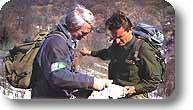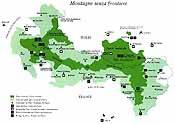
 |
Parco delle Alpi Marittime |
Parco delle Alpi Marittime and Parc National du Mercantour towards a European Park |
|
 |
Since Parco Alpi Marittime and the Parc national du Mercantour share a border of 35 km, they protect an area of over 100,000 hectares which includes the mountains Gelàs, Argentera and Mercantour.
The main priorities of these parks are the conservation of the biodiversity and of the landscape, to educate children and adults, to increase awareness, and further sustainable development. Both the protected areas derive from the ancient game reserve of the king of Italy, Vittorio Emanuele II. It covered both sides of the Alps before the treaty of Turin returned the County of Nica to France in 1861. In spite of that, the Reserve remained under Italian sovereignty until the end of the Second World War. Later on, France and Italy established their respective game reserves, which were then transformed into protected areas: Parc national du Mercantour, in 1979, and Parco Naturale dell'Argentera, in 1980. In 1995 the latter was extended and called Parco delle Alpi Marittime. |
A Natural Frontier |
|
| The inhabitants of the parks' territories were connected a long time before the creation of the game reserves. There is evidence of human presence in prehistoric times in the Vallé des Merveilles in France, this monumental complex which includes thirty thousands rock pictures. Further evidence was found at Vej del Bouc in Italy. Later, the economic exchanges developed thanks to the "salt routes". The cultural and religious links are still strong thanks to Occitan, a language spoken on both sides. | |
Twinned Parks |
|
 |
Parc national du Mercantour and Parco delle Alpi Marittime have been linked since 1987. The twinning agreement has encouraged common enterprises: bilingual publications, the project to reintroduce ibex, wildlife monitoring, communication (film, exhibitions, magazines). In 1993 the European Council awarded these parks the "European Diploma for the Environment". In the same year the project to reintroduce lammergeiers began. In 1998 the two Parks signed a new twinning agreement confirming their dedication to work together. The new twinning expresses the will to intensify the common activities regarding scientific research, management, territorial planning, sustainable development, and school activities. The Parks' intent is to enhance the value of the natural heritage to be hand over to future generations. |
Park Addresses |
|
|